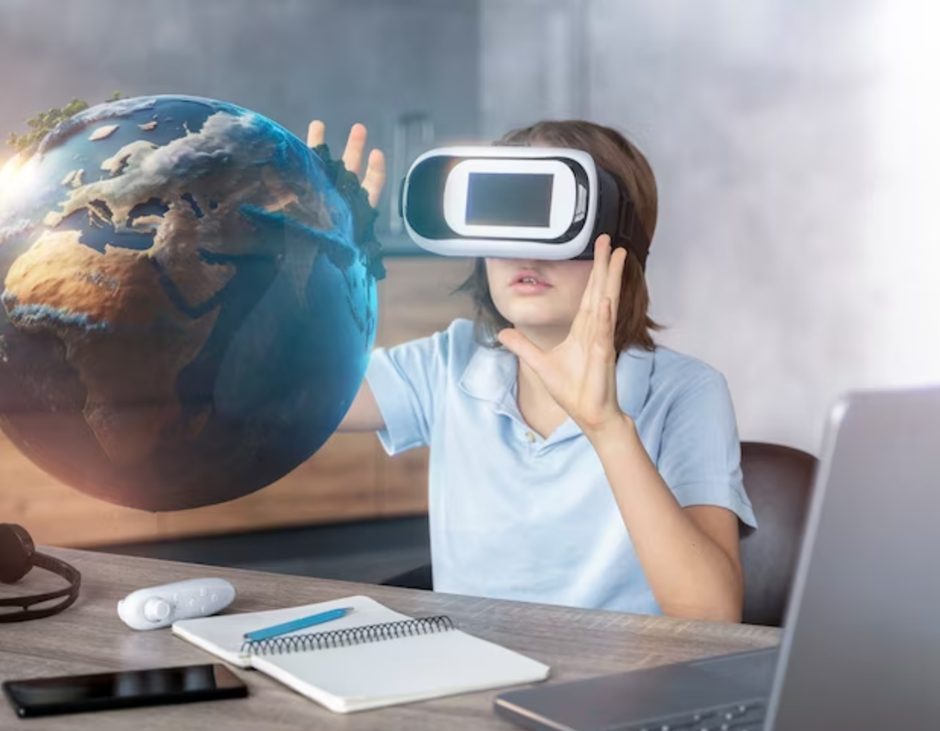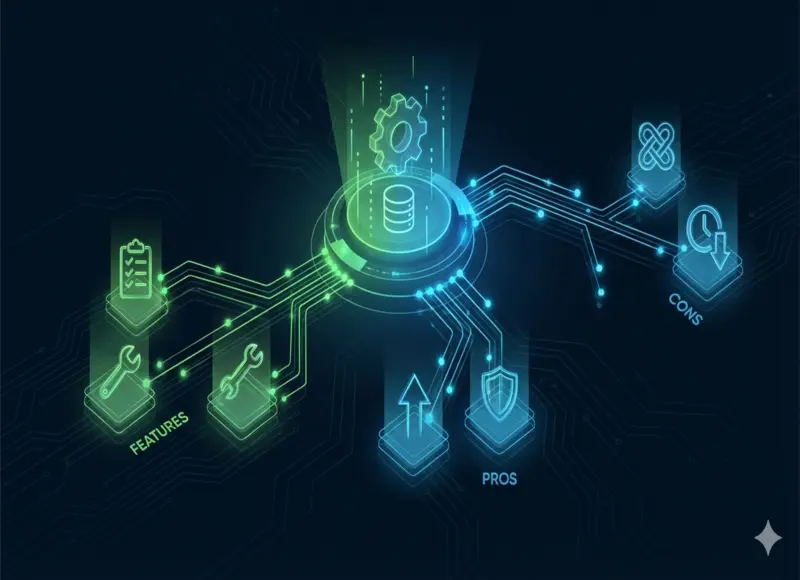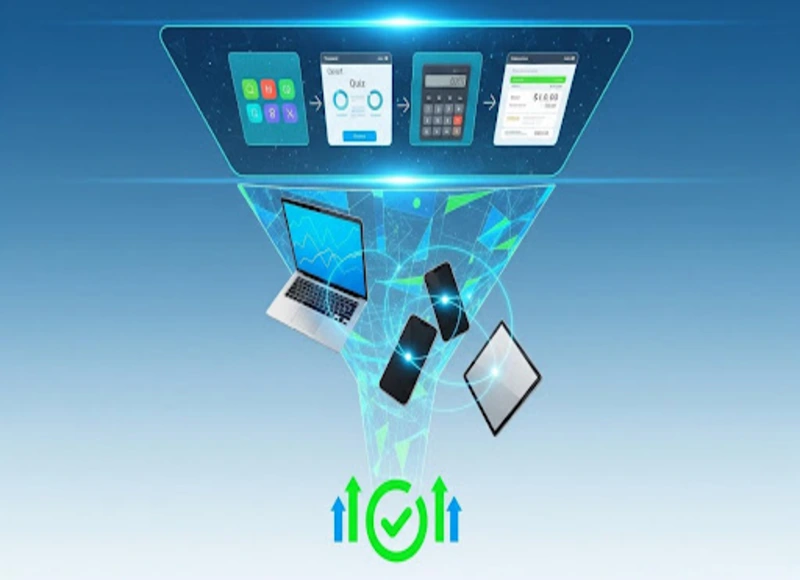Table of Contents
Discover the new frontier of user experience with augmented reality integrated into web design.

With the the ultimate importance of a strong online presence, top-notch web design is vital for any business. It can make a huge difference when it comes to user engagement, brand reputation, marketing success, and competitiveness, all of these factors largely relying on the digital user experience. This is where Augmented Reality (AR) comes into play, making a huge difference in crafting a user-centric web design.
AR at a Glance
Augmented Reality (AR) technology operates by superimposing digital content onto the real world, seamlessly blending virtual elements with the physical environment. Unlike virtual reality, which creates a wholly new digital setting, AR supplements the existing surroundings with additional layers of information. The core components of the tech include:
- Sensors and Cameras: AR relies on various sensors like GPS, accelerometers, gyroscopes, and cameras to understand the user's environment and position digital content accurately.
- Computer Vision: Algorithms and computer vision technology analyze real-world imagery, enabling virtual systems to recognize objects, surfaces, and spatial mapping for precise placement of simulations.
- Display Devices: Simulated experiences are viewed through devices like smartphones, tablets, smart glasses, or web browsers, which overlay digital information onto the consumer's view of the real settings.
- Content Creation Tools: Developers use specialized software to create AR content, allowing them to design and naturally integrate simulations into the client's environment.
AR in Web Design
In web design, AR enables the mixing of digital simulations into websites, providing users with an enriched and interactive experience directly within their browsers. The importance of such integration lies in its ability to revolutionize the traditional browsing experience. By transforming static web pages into dynamic and interactive environments, it opens new avenues for user engagement, enabling businesses to create compelling storytelling, immersive product experiences, and interactive educational content.
Moreover, AR in web design fosters greater user retention, as it encourages exploration, interaction, and a deeper connection between customers and the content they consume. As technology advances and user expectations evolve, such integration becomes a crucial element in providing innovative, engaging, and user-focused online experiences.
Several notable examples showcase the successful integration of AR in web design:
- Virtual Try-Ons: Retail websites offer AR-based try-on experiences for products like clothing, glasses, or makeup, allowing clients to visualize how items look before making a purchase.
- Interactive Product Demonstrations: Platforms featuring interactive models or simulations that enable prospects to explore products in 3D, such as furniture, vehicles, or gadgets, enhancing the shopping experience and facilitating the decision-making process.
- Education and Informational AR: Educational websites use simulations to ensure interactive learning experiences, such as AR-enabled textbooks or virtual historical tours.
- AR Gaming: Websites host AR games that users can play directly through their browsers, merging gaming experiences with the real world.
Benefits of AR Integration in Web Design
Integrating simulations in websites is becoming mainstream and for a good reason. Virtual functionality offers a spectrum of benefits that redefine user engagement and interaction, making modern web design an efficient marketing and lead-generation tool.
- Enhanced User Experience (UX): AR elevates the level of engagement by offering immersive and interactive experiences. Overlaying digital components onto the existing setting creates a more exciting and personalized user journey.
- Visualizing Products and Services: Businesses can showcase their products or services in a more interactive manner. For instance, customers can cast a look at how furniture might look in their homes or how clothing items might fit them before making a purchase. This promotes confidence and reduces return rates.
- Increased Involvement: Simulations encourage prospects to actively participate rather than passively consume content. This involvement can lead to longer session times on websites and increased brand loyalty.
- Personalization: Whether it's customizing product colors, sizes, or functionalities, AR empowers users to personalize their interactions, fostering a sense of ownership and satisfaction.
- Differentiation and Competitive Edge: The best web design driven by AR technology sets businesses apart from competitors, demonstrating a commitment to innovation and providing cutting-edge experiences that attract tech-savvy audiences.
- Analytics and Insights: AR integration can provide valuable data insights into customer behavior and preferences. Analytics can track how clients interact with simulated elements to help marketers refine their marketing strategies and improve user experiences.
- Accessibility and Convenience: The tech on the web removes the need to download separate apps, making experiences more accessible and convenient. They can access virtual features directly through web browsers, eliminating any additional steps.
- Future Scalability: As technology advances, integrating it into web design positions businesses for future advancements and innovations in the field. It allows for easier adaptation and incorporation of new AR capabilities.
With these advantages in the digital space, businesses especially it companies in us are equipped to pave the way for future technological advancements while standing strong or even taking the lead in the industries. With AR-enabled web design, companies can rest assured they’ve gained secure supportive power for future development and growth.
AR Impact on User Experience

The evolution of AR has significantly transformed user experiences across various industries. Initially popularized through mobile apps and gaming applications, simulated reality has evolved from a niche technology to a mainstream tool, impacting how consumers interact with digital content.
Its integration into web design is all about how users engage with online platforms. AR has passed a long way from its inception and simple overlays to sophisticated, context-aware experiences that have redefined the boundaries of user interaction, enabling a more immersive, engaging, and personalized UX," says Artur Bien, a senior UX designer at Whop.
"Augmented Reality is revolutionizing web design by creating more immersive and interactive user experiences. By seamlessly integrating digital elements into the physical world, AR allows web designers to transcend traditional boundaries, offering users a dynamic way to interact with online content. This not only enhances user engagement but also provides a platform for innovative storytelling and personalized experiences."
Improved Interactivity and Immersion
Simulated reality significantly elevates UX by creating a dynamic, multi-dimensional interaction between users and digital materials:
- Immersive Engagement: AR blurs the lines between the digital and physical worlds, allowing clients to interact directly with virtual features in their real settings. This immersion boosts engagement levels, as users actively participate in the experience instead of simply watching and trying to imagine how the item or product looks in reality.
- Real-Time Interaction: Virtual features provide real-time information overlays, such as directions, instructions, or additional details about products. Through such interactions, users can manipulate, explore, and engage with content in a way that feels organic and natural.
- Spatial Understanding: AR provides a spatial understanding of digital elements in the user's environment, leading to a deeper comprehension and connection with the given info or products.
Enriched Storey Telling and Brand Communication
AR can be a powerful tool for storytelling, enabling brands to narrate their story and showcase their values to the target audience in a more enticing way.
- Dynamic Narratives: Simulations allow brands to craft dynamic and interactive narratives that unfold in real-time, captivating users and creating memorable experiences.
- Emotional Connections: By immersing users in interactive stories or brand experiences, the tech fosters emotional connections, making the content more relatable and memorable.
- Brand Differentiation: Well-crafted AR-driven storytelling sets brands apart, providing a unique and innovative experience that not only demonstrates the brand’s identity but also distinguishes them from competitors.
User Feedback and Response to AR-Enhanced Web UX
The perception and feedback to AR-enabled web experiences have been overwhelmingly positive:
- Increased Engagement Metrics: Websites incorporating the tech often witness higher engagement metrics, including increased time spent on site, lower bounce rates, and higher interaction rates.
- Positive User Reactions: Customer feedback typically reflects excitement, curiosity, and a desire for more interactive and immersive content.
- Conversion and Retention: AR's ability to draw individuals in and keep them interested often translates into improved conversion rates and increased customer retention, as users are more likely to return for the exclusive experiences offered.
Best Practices for Incorporating AR in Web Design
Augmented Reality is undoubtedly a game-changer for modern web design, making it even more customer-oriented and engaging. However, tech integration is a multi-faceted process covering a few essential stages. Here is what web designers should take into account to succeed in virtual features incorporation into their online frameworks and enable businesses to reap AR benefits to the full.
- Meaningful Integration: Identify the specific user needs and objectives for the simulated reality integration. Focus on enhancing UX rather than implementing the tech for the sake of novelty and hype.
- Simplicity and Usability: Keep virtual elements intuitive and easy to use. Strive for simplicity in design to ensure effortless interaction for users of varying technical abilities.
- Contextual Relevance: Ensure that simulations align with the website's context and content. Such appropriateness will enhance engagement and prevent the tech from feeling disconnected or out of place.
- Optimized Performance: Prioritize optimization to ensure simulated components load quickly and function smoothly across various devices and network conditions, avoiding user frustration due to slow or glitchy experiences.
- Accessibility Considerations: Make AR accessible to as many people as possible by ensuring compatibility with a wide range of devices and providing alternative options for those who may not have access to AR-capable devices.
Web designers should closely collaborate with developers and marketers to create compelling and user-centric AR experiences that enhance the overall web browsing journey.
Future Trends in AR Technology for Web Design
Though not new to the digital world, AR is not at its peak yet and is still evolving. Hence, there are more exciting opportunities around the corner for enhancing user experiences on the web.
- WebAR Boom: The ongoing advancement of WebXR and browser capabilities will lead to more sophisticated simulations directly accessible through web browsers, reducing the need for standalone apps.
- AR Cloud Development: The concept of an AR cloud, a persistent and shared digital layer over the physical world, will evolve, enabling seamless virtual experiences across different locations and devices.
- Spatial Computing: Innovations in spatial computing will enable user interactions more natural, allowing for more intuitive and context-aware experiences.
- Integration with AI and IoT: AR will converge with artificial intelligence and the Internet of Things (IoT), creating interconnected and intelligent experiences that anticipate user needs and enhance functionality.
- Augmented Commerce: AR will reshape e-commerce by offering hyper-realistic product visualizations, leading to increased online sales and improved decision-making for shoppers.
Final Thought
The integration of simulated reality in web design presents an exciting frontier for designers, developers, and businesses. By embracing the tech and harnessing its potential, they can create compelling, immersive, and user-oriented experiences. Such an approach in turn will redefine the way users engage with digital content, shaping the future of online interactions.
Recent Blogs
Key Benefits of Hiring Nearshore React.js Development Teams for Enterprise Projects
-
20 Jan 2026
-
10 Min
-
127
Stop Building from Scratch: Boost Your Marketing Funnel with App Templates
-
13 Jan 2026
-
10 Min
-
467







